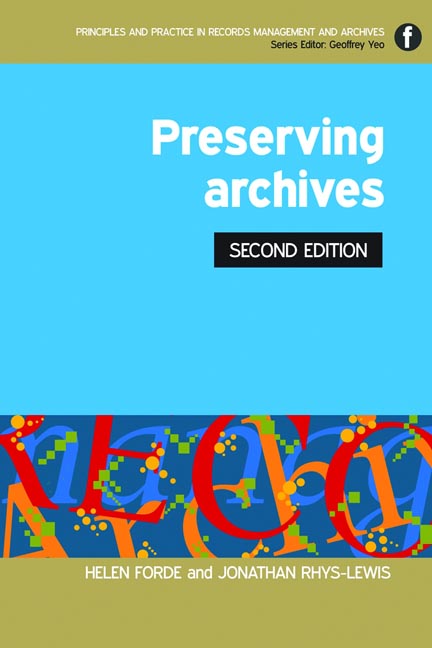Book contents
- Frontmatter
- Contents
- Introduction to the series Geoffrey Yeo
- Preface to the Second Edition
- Acknowledgements
- 1 Introducing archive preservation
- 2 Understanding archival materials and their characteristics
- 3 Managing digital preservation
- 4 Archive buildings and their characteristics
- 5 Safeguarding the building and its contents
- 6 Managing archival storage
- 7 Managing risks and avoiding disaster
- 8 Creating and using surrogates
- 9 Moving the records
- 10 Exhibiting archives
- 11 Handling the records
- 12 Managing a pest control programme
- 13 Training and the use of volunteers
- 14 Putting preservation into practice
- Appendices
- Bibliography
- British and international standards relating to archive preservation
- Index
9 - Moving the records
Published online by Cambridge University Press: 09 June 2018
- Frontmatter
- Contents
- Introduction to the series Geoffrey Yeo
- Preface to the Second Edition
- Acknowledgements
- 1 Introducing archive preservation
- 2 Understanding archival materials and their characteristics
- 3 Managing digital preservation
- 4 Archive buildings and their characteristics
- 5 Safeguarding the building and its contents
- 6 Managing archival storage
- 7 Managing risks and avoiding disaster
- 8 Creating and using surrogates
- 9 Moving the records
- 10 Exhibiting archives
- 11 Handling the records
- 12 Managing a pest control programme
- 13 Training and the use of volunteers
- 14 Putting preservation into practice
- Appendices
- Bibliography
- British and international standards relating to archive preservation
- Index
Summary
Introduction
Moving all or part of an archive is a daunting experience and one which needs to be approached in a very organized way. It is highly likely that many archivists will have to organize a move at some point in their careers. A successful move will ensure that:
• the material is undamaged by either the move or the new surroundings into which it is put
• access to the materials is interrupted for as little time as possible.
That said, any move is a serious risk which needs to be minimized as far as possible by good planning and efficient execution. This chapter looks at:
• the risks involved in moving archives
• managing the move
• briefing a removal firm
• the equipment required
• preparing for the move
• the move itself.
What are the risks?
Listing the preservation risks offers a good way to identify those which can be reduced and those which will have to be monitored throughout the process. Any of the following might be a problem:
• If there is a lack of clarity about the scope and purpose of the move it will be very difficult to retain control over the operation. Both scope and purpose should be spelt out in detail to inform those who are involved and clarify their roles.
• The parent organization – e.g. business, university or local authority – may not fully understand the requirements of the archive for moving.
• A complete move of an archive involves many factors and requires logistical expertise which may not be available in- house. Even a small move within an archive is complicated.
• The decision to move may not leave sufficient time or budget for the operation to be undertaken in the optimum way. Skimping on time for planning will affect the success of the outcome and introduces additional hazards. Poor budgeting will lead to risks that essential preservation procedures, such as boxing and wrapping, are not undertaken or too few staff are involved to guarantee the safety of the archive.
• If the material is in poor condition or is not adequately protected it risks additional damage in transit, and subsequent inaccessibility to readers.
- Type
- Chapter
- Information
- Preserving Archives , pp. 139 - 158Publisher: FacetPrint publication year: 2013



